Unveiling the Hidden Worlds of Display Technology
Imagine walking into a room where the walls aren’t just passive surfaces but dynamic storytellers, whispering tales, showcasing art, or transforming in an instant. This isn’t science fiction anymore—it’s the fascinating evolution of display technology. If you’re as intrigued as I am about how screens are shaping our future, I highly recommend checking out the display magazine. It’s a treasure trove of insights into the latest trends and innovations that are redefining how we perceive visuals.
The Power of Archetypes in Display Design
What Are Display Archetypes?
Think of display archetypes as the fundamental characters in a story. Just like the hero, the villain, or the wise mentor in a sci-fi saga, these archetypes serve as the foundational templates that guide how displays communicate and engage audiences. They aren’t just random designs; they embody specific narratives and emotional cues, shaping the viewer’s experience without uttering a word.Why Do Archetypes Matter?
In a universe saturated with information, clarity is king. Archetypes cut through the noise, providing familiar visual language that our brains instinctively understand. This is especially crucial as digital displays become more immersive and integral to our daily lives—think of smart cities, interactive museums, or personalized retail experiences. By leveraging archetypes, designers craft visuals that resonate deeply, making complex messages feel intuitive and relatable.From Science Fiction to Reality: The Evolution of Display Archetypes
The Roots in Classic Storytelling
The concept isn’t new; it’s rooted in storytelling traditions. In sci-fi movies, certain visual motifs—like the holographic interfaces of “Star Trek” or the neon-lit cityscapes of “Blade Runner”—have become archetypal. These visuals tell a story of the future, of advanced technology intertwined with human experience. Today, designers draw inspiration from these narratives to craft display archetypes that evoke familiarity while pushing the boundaries of innovation.The Journey Toward Immersive Experiences
Recent advancements have birthed a new era where displays aren’t just screens but portals to other worlds. Think of augmented reality overlays or transparent OLEDs that blend seamlessly into the environment. These innovations rely heavily on archetypal design principles—familiar shapes, intuitive interfaces, and emotionally resonant visuals—to ensure users feel comfortable navigating these high-tech landscapes.Storytelling Through Design: Making the Complex Simple
Imagine a future where your city’s billboards adapt to your mood, or your home’s wall displays shift to tell a story that fits your evening. This narrative-driven approach is not just about flashy tech; it’s about creating a seamless connection between human emotion and digital innovation. By understanding and applying archetypes, designers craft displays that tell stories, evoke feelings, and ultimately, make complex data accessible.The Role of Human-Centered Design
At the heart of this evolution is the principle of human-centered design. Displays are no longer just about showcasing information—they’re about creating a dialogue. When archetypes are used thoughtfully, they serve as the language that bridges the gap between technology and human experience, transforming passive viewing into active engagement.The Future Is a Story Waiting to Be Told
Looking ahead, the horizon is bursting with possibilities. Imagine holographic displays that adapt to your needs, or AI-driven visuals that understand your preferences and craft personalized stories in real-time. These aren’t distant dreams—they’re emerging realities grounded in the storytelling power of archetypal design. As sci-fi geeks and tech enthusiasts, we’re on the cusp of a new narrative era—where displays don’t just show information but become storytellers in their own right. The journey from static screens to immersive, emotionally resonant worlds is a story worth following, and the blueprint lies in understanding these archetypes that underpin our visual future.Checkout ProductScope AI’s Studio (and get 200 free studio credits)
